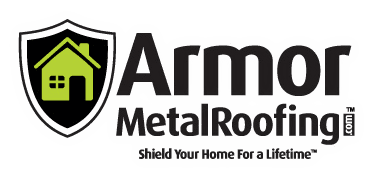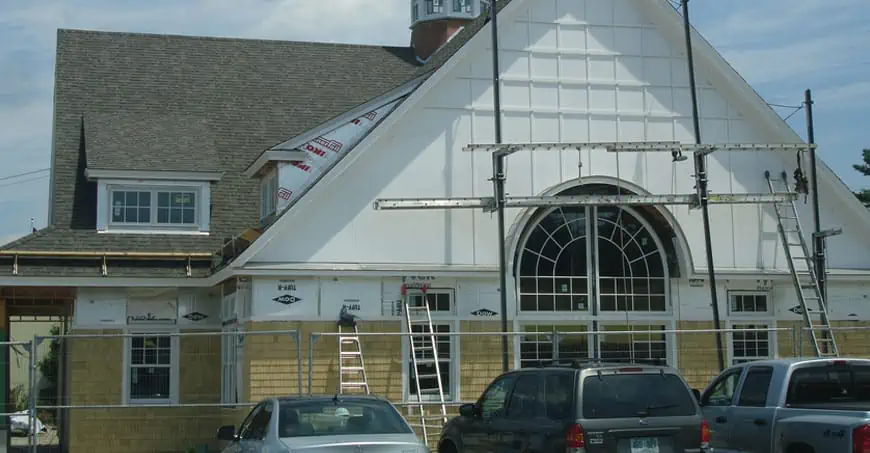Asphalt Roof Guide by Armor Metal Roofing
There are dozens of materials and roofing systems available for residential and commercial use – everything from glass derivatives to fiber-cement to wood and slate tile and everything in between. But perhaps the most common and widely recognized are asphalt roofing shingles. Widely available, economical, durable, and easy to install and maintain, this 100-plus year old roofing material is the number one choice foe home and business owners in the United States and Canada.
What are asphalt shingles?
Everyone has an idea of what asphalt is, often identifying it first by smell and then sight. It’s the black, sticky, tar-like substance that may get pliable in the heat – with foot prints or tire marks left behind on it during hot weather. It’s also known as bitumen, a natural substance present in most crude petroleum and in some natural deposits. Asphalt is best known for its use in the construction or patching of roads and parking lots, but also is the most popular material used for commercial and residential roofing projects in the United States and Canada. How popular? More than 12.5 billion square feet of asphalt roofing products are made each year – or enough to install roofs on more than five million new homes annually, as reported by the Asphalt Roofing Manufacturer’s Association.
Types of asphalt shingles
There are two types of asphalt shingles in use in the North American market: fiberglass-based or organic-based. Fiberglass-based asphalt shingles are made using a mat composed solely of glass fibers of varying shapes and lengths. The fiberglass mat is then combined with a specially-formulated asphalt coating, followed by the weather-resistant mineral granules that most consumers associate with asphalt shingles. Organic-based asphalt shingles are made with a mat composed of different cellulose fibers, including waste paper and recycled wood fibers. The manufacturer then soaks the base in the same specially formulated asphalt coating as the fiberglass kind, which is then covered using weather resistant mineral granules. It’s during this point in the manufacturing process that the shape of the shingle is determined, though the most common shape is oblong.
Fiberglass shingles are most commonly used in the south and central United States, and offer the benefit of being more light weight, fire resistant, and less prone to cracking through prolonged exposure to environmental and other damage.
Structures in the northern U.S. and Canada use organic shingles, mostly because they are known to be stronger, more durable, and more flexible in colder weather conditions. This is especially important in geographic locations that experience regular periods of sub-freezing weather followed immediately by warmer temperatures.
Within these two categories are four other sub-categories worth mentioning:
- Strip Shingles, which can be up to three times as long as they are wide. Made in standard and metric dimensions, they are easily recognizable by the number of cutouts or tabs on each shingle. The “three-tab” shingle is the most common type of strip shingle. This type of shingle allows for the greatest number of different textural and lighting or shadowing effects, depending on the number, shape and alignment of the cutouts.
- Laminated Shingles have more than one layer of tabs to create extra thickness. They are also called architectural or three-dimensional shingles because they give a roof the visual depth and aesthetics of a custom design. They are favored by builders, roofing contractors and homebuyers.
- Interlocking Shingles have a unique design that allows them to mechanically fasten to each other, which provides greater wind resistance. They come in different shapes and sizes and offer a wide range of design possibilities.
- Large Individual Shingles do not use cutouts or tabs and are normally rectangular or hexagonal in shape.
Installing asphalt roofing shingles
In most cases, construction and home improvement professionals make their jobs look easy, whether it’s installing a brick paver, new windows, or a new asphalt shingle roof. But there’s more involved than meets the eye. A successful installation depends on knowledge, experience, tools and material, and proper weather conditions, among other factors.
Each of these contributes to how long installation takes. In some cases, a new asphalt shingle roof could be installed in as little as a day, while larger homes or commercial structures could take several days or more time. There is no set formula that determines how long an installation will take, and even contractual obligations are susceptible to the same issues.
Installing an asphalt roof takes the following steps:
- Inspecting the roof and planning the project. This is, perhaps, the most critical part of the installation because it’s the point where measurements are taken and the materials list and project estimate are created.
- Putting down roofing paper (normally the thick, 15-pound variety) on the roofing deck, and attaching it with staples on the edges and seams.
- Securing the drip edge or metal flashing around the outside edges of the roof deck with 6d roofing nails. Make to use 6d nails that are specified for roofing or outdoor use.
- Use a chalk line to mark all areas on the roof where the shingles are to be laid, one row after the other.
- Some shingles may need to be trimmed or cut to size, especially those that will underlay another shingle or rows of shingles.
- One helpful tip is to pre-nail the shingles upside down along the chalk line, then drop a bead of asphalt cement with a caulk gun along the drip edge. The next step is to press the shingles firmly into the cement, waiting 30 to 60 seconds for the adhesive to take hold.
- Secure each shingle row by row, cutting to size where needed and repeating this process all the way to the ridge line.
- For the peak of the roof, bend a shingle over the ridge, securing it on the other side if the shingle exceeds the top of the ridge. Using ridge singles are an option. In all cases, use a bead of asphalt under the first ridge shingle to hold down the tab till the roofing cement takes hold, and then finish it off with nails along the edges.
ROOF SLOPE
Homeowners who wish to install an asphalt shingle roof themselves are sometimes confused as to what slope is appropriate. In most cases, don’t go lower than 2:12 which translates to two inches of vertical rise for every twelve inches of horizontal run or distance. Anything between 2:12 and 4:12 (four inches vertical rise, 12 inches horizontal run), may require installing two layers of #15 felt underlayment, which helps reduce the exposure of the shingle – the portion of the shingle that remains visible after installation. In lieu of both of these, the project may necessitate installing a self-adhering ice and water underlayment over the entire roof deck surface.
Tools and materials used
When an asphalt roofing system is installed, the materials and tools used are fairly straight forward and include:
- The shingles themselves.
- Roof deck. The most common materials used for roof decks are plywood or oriented strand board (OSB).
- Underlayment or felt paper is laid over the roof deck before installing the asphalt shingles. An underlayment serves two functions: temporary weather protection until the asphalt shingles are installed, and secondary weatherproofing barrier in the event moisture makes its way past the asphalt shingles.
- Fasteners. The National Roofing Contractors Association recommends the use of 11-gauge or 12-gauge galvanized steel or the equivalent corrosion-resistant roofing nails.
- Flashing (perimeter edge metal, penetrations, valleys and vertical surfaces).
Common tools used are hammers, saws (hand or powered), pry bars, utility knives, chalk line, tape measures, levels, and a ladder, among others.
Cost and Benefits
The price of asphalt shingles in Maine and New Hampshire depends on many factors a residential or building owner can’t control, like where the structure is located and how often it’s exposed to extreme or damaging weather conditions, how quickly the customer needs the roof installed, what kind of previous workload the roofing contractor is obligated to, and manufacturing costs. Asphalt roofing materials, because they are a by-product of crude oil, are subject to the same price fluctuations as gasoline.
Because prices can fluctuate depending on market conditions, it’s advisable to verify materials lists available through roofing contractors, home improvement retailers, or by contacting the Asphalt Roofing Manufacturer’s Association for referrals and related information.
Asphalt roofing shingles are more durable than other roofing materials like wood or solar panels, but their lifespan depends on many different factors. With proper maintenance, some asphalt roofs can last 20 to 50 years under ideal conditions, which means temperate climates and limited exposure to storms and volatile weather.
Here are some of the benefits of asphalt roofing shingles:
- They are inexpensive when compared to other materials, such as Thermoplastic roofing systems, EPDM roofing systems, Photovoltaic panels, and green roofing systems.
- Beginning roofing installers or even seasoned do-it-yourself homeowners can install asphalt shingle roofs.
- Simple to repair, allowing for single shingles to be repaired or replaced.
- A long lifespan.
- Asphalt shingles are available in many colors, which hold up well during prolonged exposure to heat and ultraviolet rays.
- Asphalt shingles generally don’t get slippery when wet.
Finally, asphalt roofing systems lend themselves quite well to regular maintenance, often benefitting from something as simple as washing away debris with a water hose or long handled brush. With regular inspection and even simple maintenance, this common roofing material has been known to last for 20 years or longer in even the most extreme environments.

